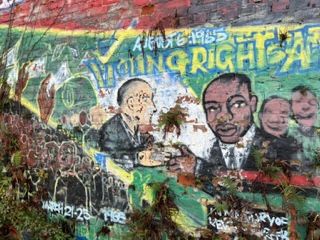Hyla Stories
Experiencing MLK’s Legacy: Student Stories

On Tuesday we gathered in the Community Hall to recognize the importance of Dr. Martin Luther King Jr.’s work and legacy. We invited upper school teacher Jeanne Stevens and students to share their recent experiences in the deep south visiting national historic monuments and museums that honor Dr. King, Coretta Scott King, and significant moments in civil rights history. Upper school students created a slideshow from their recent trip to Georgia and Alabama as part of their Panorama course that focused on social justice movements in the US. “They recently got back from their trip,” said Assistant Head Peter Berner-Hays, “so these experiences are very fresh in their minds. Gathering together the day after MLK Day was an important and timely way for students to learn from and with each other.”
As upper school students shared personal photos from memorials and museums, they also shared their personal stories about how it felt to experience these historically significant places, like the Edmund Pettus Bridge. Now a National Historic Landmark, the bridge is a key feature along the 25-mile Selma to Montgomery National Historic Trail that follows the route of the 1965 Voting Rights March, which was led by Dr. King and the first voting rights march in the US. On this very bridge, marchers were brutally confronted by police and the bloody scenes were televised around the nation, prompting outrage and growing support for the movement. After a Federal Judge granted the marchers court protection, the march continued and grew from 600 people to over 3,000, reaching 25,000 strong by Montgomery. In December, Hyla upper school students got to walk in the footsteps of these brave Americans. During their presentation yesterday, students talked about how it felt to be at the site of such a pivotal moment in our nation’s history. Still wrestling with the emotional weight of the experience, one student narrated the photos by saying: “We were going across this bridge… but we were going across THIS bridge.”
Another student talked candidly about how the experience of being in the south changed their beliefs and expectations about that region. They openly acknowledged having a negative view of the region before the trip, and talked about how the experience of being there – meeting people, seeing places, and listening – gave them a much deeper understanding for the complexity of the region, the complexity of race relations, and the complexity of the people still doing the work to be better. Through this personal sharing, middle schoolers could hear how valuable travel and immersive experiences can be to confronting our own stereotypes and misconceptions about people and places. As Peter said, their personal stories “elevated the importance of going to a new place.”
Other students introduced the Equal Justice Initiative’s Legacy Museum – that covers enslavement to mass incarceration – and the adjacent National Memorial for Peace and Justice, a sprawling 6-acre memorial that honors the victims of racial terror lynchings. Students talked about needing to sit in silence for a long time to process the intellectual and emotional weight of these spaces. They talked about how the intensely moving and profound experiences of the museum and the memorial helped them reach a deeper understanding of what civil rights work is truly about. They specifically emphasized that civil rights work is not a movement from the past: it’s ongoing and urgent work that is still happening now, with a whole new generation of leaders and participants.
After the presentation, middle school students broke out small groups for discussion and reflection, with these conversation starters:
• Why is it called the Deep South?
• Why do we have the MLK holiday as a day off at Hyla?
• What jumps out at you as you think about the US students’ comments?
• What are some ways you might share today’s presentation and conversation with others?
“Given geography and the racial demographics of our area, it could be easy to default to feeling distanced from that part of the country,” said Peter. “It was clear that for our upper school students, the experience of visiting the south shortened that distance for them emotionally and academically. Watching our middle schoolers listen attentively to stories from older students, it was clear that distance was shortening for them, too – and that’s why we do this.”
